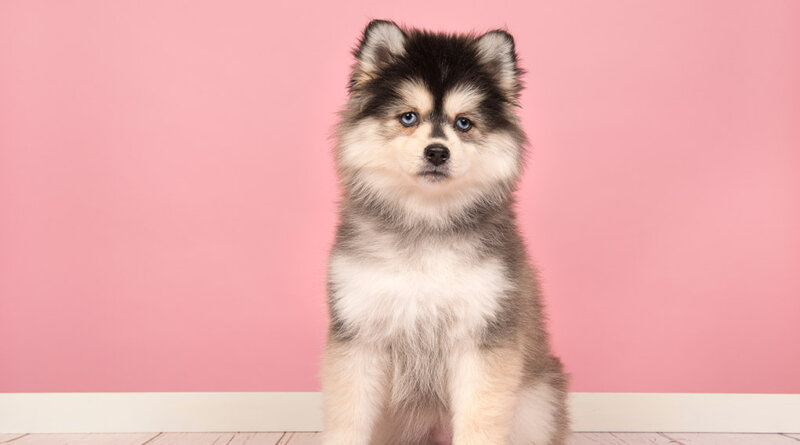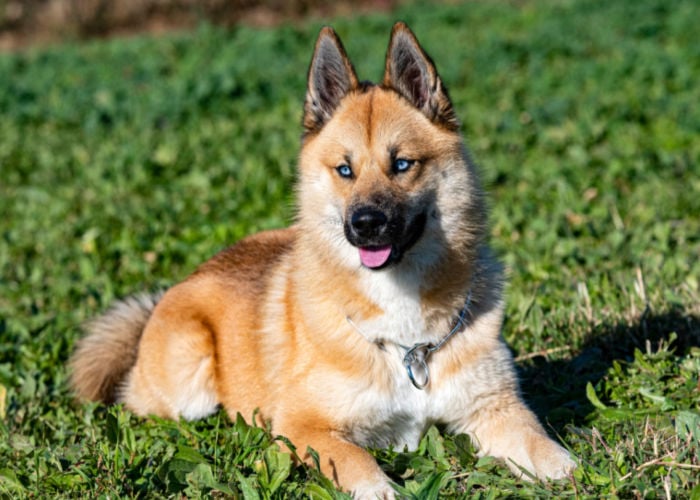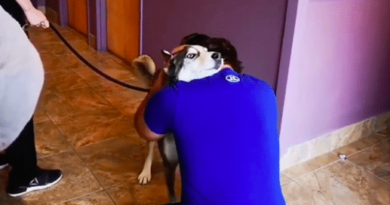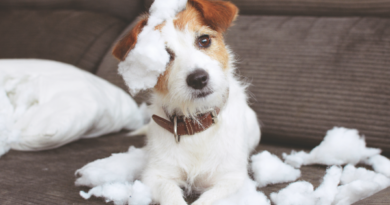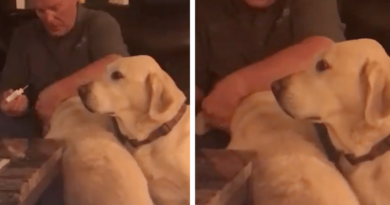Pomsky Dog Breed Profile – Top Dog Tips
Now if we’re talking about cute mixed breeds, one of the few dogs that come to my mind is the Pomsky.
Pomsky is a designer breed mixed between a Siberian Husky and a Pomeranian.
So with these breeds as their parents, we can only guess the outcome. An adorable, fun, and silly pup that you can cuddle in your apartment!
These pups are like fluffy miniature wolves. Their appearance is one of the reasons that this breed is still gaining popularity.
If you’re planning to adopt a Pomsky puppy, it is best advised to adopt from a reputable breeder to ensure that you’re getting a healthy pooch.
Unfortunately, even though these pups are so adorable, they are often surrendered to shelters or rescue groups. This is because some owners are unprepared to deal with their needs and commitment.
Owning a dog is not easy at all. You’re the one responsible for giving them shelter, food, affection, and many more. Being a pet parent will also not be cheap.
That’s why before adopting a pet, you need to take into consideration a lot of things. And here are the things you need to know before getting your own Pomsky.
Pomsky History
Pomsky first gained popularity back in 2011. This breed went viral due to a Buzzfeed blog post that featured photos of Finnish Lapphund puppies, claiming they were a cross between a Siberian Husky and Pomeranian.
The internet was in a frenzy. And since those dogs aren’t Pomskies at that time, the demand for the making of that certain breed sparked.
Enterprising breeders heard these and they were willing to quickly make it happen. There are reports that Pomskies were created around 2009, but the first officially recorded Pomsky litter was in 2012.
However, due to the size difference between the Siberian Husky and the Pomeranians, natural breeding is unsafe.
That’s why breeders use artificial insemination when it comes to creating Pomskies. Also, this is why Pomskies are still very rare and expensive.
On the other hand, Pomskies are not recognized by most breed organizations. Since the Pomsky breed is a hybrid dog, large dog breed organizations like the American Kennel Club do not recognize this dog breed.
Fortunately, there are now other groups and organizations specifically for Pomsky breeders, owners, and fans.
A few examples of these are the Pomsky Owners Association, Pomsky Club of America, and the International Pomsky Association.
Physical Characteristics of a Pomsky
This breed does not have a definite height and weight, as their size varies from small to medium. Pomsky may stand to 10 inches to 17 inches in height, weighing around 7 to 38 pounds.
A Pomsky has a double coat, with a long and fine outer layer while it’s denser and shorter in the inner layer. Their coat color may vary depending on their purebred color range.
Their eyes mostly come in lighter colors, like the Husky. The Pomsky nose is similar to the Husky as well, but the muzzle is shorter like the Pomeranians. Their ears are high and long.
Pomskies’ head is quite large with small features. Their neck is thick and extends well from their body. Pomskies’ chest isn’t prominently protruding but it has a slant appearance.
Their forelimbs and back limbs are quite long and slim. Their tail arches in the back with a curve.
Pomsky Temperament
Pomsky is like having that one friend who’s always on about something, makes you laugh, and is loyal. Pomksy is quite the charmer and they are great as a companion and a family dog.
They are excellent around children as well but of course, as responsible owners and guardians, it’s best not to leave them unsupervised.
Pomsky may take time in assessing strangers. If there is someone new and quite suspicious, they may start with their protective instinct.
However, if they have observed that their owner is welcoming those strangers, they’ll gradually welcome them as well.
This breed may not be great with other dogs and animals but with the help of early socialization, exposure, and positive association, Pomsky may learn to adapt social skills and be less wary of their surroundings all the time.
Pomsky is quite flexible in terms of space requirements. As long their needs are met, they can adapt to their owner’s home.
Warning though, as Huskies and Pomeranians are known to be both vocal breeds, and a Pomsky did not lack in this trait as well.
That’s why Pomsky is a capable watchdog. They’re quite vigilant and quick to respond to situations. They will bark to warn the stranger and their owner to nay peculiar activity.
Living with a Pomsky
Pomsky is best in homes or areas in cool weather. They are tolerable with warm weather but it’s best to keep them cool most of the time, especially when the weather is warm.
Pomsky is best not left alone at home. They’re intolerable of being alone and may become destructive and noisy. They should be left with someone they know if you are planning to leave for a while.
Pomsky may not be the best option for owners who are new to taking care of dogs. The Pomsky dog breed can be quite challenging.
Owners with no experience will face difficulty handling Pomsky as they grow older. After all, they need a lot of patience and commitment to train.
Guidance from veteran pet owners, behaviorists, or veterinarians may help but it’s best to have prior experience.
Training & Exercise
Pomsky is quite an intelligent breed. They may require ample mental and physical stimulation, better in a variety of ways.
Pomsky is also known to be quite stubborn, so it’s best to get them cooperative by introducing them to different activities.
Pomsky is moderate to train. It may require much more energy to train this breed, as they are intelligent and can easily get bored with repetitive activities.
Preparing dog toys and treats, generous compliments and attention can help them get fired up with training
Early exposure and socialization are quite important to this breed. They may end up being overly protective or yappy if left as when they were young.
Their curiosity may match their vigilance, so it’s best to expose them to different things whilst young.
Exercise for Pomsky is quite important, although they don’t need an extensive exercise regimen. They still need those daily walks.
You can take them out for a walk for at least 40 minutes a day. Owners may even use playtime in the backyard or park as exercise.
It’s important to have them exercised daily as they get easily bored and may become destructive. Plus, nothing beats putting your dog’s health as a top priority.
Pomsky Health Care
Pomsky can be very healthy as they can live from 10 to 15 years. Since Pomsky is a mixed breed, common health problems may still be indefinite.
But some of the common problems may be the following:
Allergies
Pomsky can develop skin allergies regardless of their age. Carefully assess if they are frequently licking or itching in certain areas repeatedly. Lethargy, bald patches, and itchy runny eyes are also symptoms.
This condition should be looked at attentively. If a Pomsky is diagnosed with a skin allergy, owners should prevent this condition from worsening.
If this condition lasts longer or increases over time, the dog may also acquire dermatitis.
Either way, the Pomsky should be checked with the veterinarian for medication or supplements needed to address the skin problem immediately. Remember to have it checked regularly and as soon as possible.
Owners should also inquire their veterinarian about what causes the allergy and what foods or activities to avoid.
Dental Problems
Pomsky is found to be prone to dental problems. Plaque build-up, tartar, and gum infections may be the first issues.
If left unaddressed, it may lead to serious health problems in the future. Prevention is the best option and immediate treatment is the key.
Hip Dysplasia
Hip dysplasia is a genetic condition wherein the socket of the joint and ball becomes distorted.
When diagnosed with hip dysplasia, it’s important to keep their weight in the normal range and have them exercise with activities that promote joint therapy.
Veterinarians may prescribe medications for anti-inflammatory/pain relievers and supplements. Prevention is the same which means keeping them active but not injuring them as well.
A treadmill walk or swimming is perfect for prevention and recovery for this dog breed.
Patellar Luxation
Patella Luxation is the patella shifting alignment out of the femur. This can range from high to low levels of luxation, requiring different treatments. Symptoms may include skipping and kicking off the leg.
It’s best to consult with the veterinarian for treatments, therapies, or procedures required to help Pomsky with this condition.
Tracheal Collapse
Tracheal Collapse is the condition in the respiratory where the cartilage of the tracheal rings collapses. It is said that it may be due to trauma to the tracheal area or maybe even genetics.
Pomsky should be checked with the veterinarian for treatments, surgery, or medication needed.
Mixed breeds are much more difficult to breed. It’s important to carefully consider the dog’s health status before going through the breeding process.
This is to avoid congenital diseases being acquired by the following litter. It’s best not to proceed once the dog has the said diseases acquired from the purebred.
This can help the next litter’s quality of life as well. It’s best to have the dog tested and regularly checked before doing so.
Owners should acquire from reputable breeders instead of buying from puppy mills.
Diet of a Pomsky
Since Pomsky varies in size, their diet should correspond to it as well. Pomsky should be provided with high-quality dry dog food or wet food.
Prepared meals can also be an option as to an interval but owners should inquire with their veterinarians first.
Since Pomsky may have allergies, owners may ask vets what food or ingredient should they give less or ultimately not give. Make sure freshwater is accessible all the time.
It’s important to keep Pomsky in shape as they are prone to hip or joint problems. Excessive weight may stress their joints and end up damaging it
Grooming
Pomsky may be extensive in grooming level. Although they have a double coat, the shedding level is quite high.
Pomsky shed especially during the summer or warm seasons. Their double coat is long and dense, and this helps their coat maintain its cleanliness longer as well.
The Pomsky dog breed must have a good grooming regimen if owners do not want a house of fur. They must have a way to get rid of the fur without affecting the house so much.
Pomsky is best brushed daily with a tangling brush or a slicker brush. This must be done especially during the summer more frequently.
Pomsky can be bathed at least twice or thrice a month. They should also be bathed after a messy activity to avoid build-up in the skin and fur.
Owners can, of course, use the help of professional grooming and set up schedules.
Pomsky should have their teeth brushed regularly as they are prone to dental problems. It’s also best to have the Pomsky’s nail trimmed or filed weekly.
They may have trouble facing their grooming routine, like their purebred origin. The best suggestion will be early exposure and positive association.
Owners should hold their paws, mouth or teeth, and ears casually as much as possible. If they see that the action is harmless, they’ll react less negatively to it.
By the time they get used to it, grooming may be more effortless. But this requires much great patience for both the owner and the dog.
Frequently Asked Questions About the Pomsky Dog Breed
Are Pomsky velcro dogs?
Yes, Pomsky has velcro tendencies. They are quite attached to their owner or family.
They may stick around a certain family member as well. However, Pomskies can become timid around other people if not socialized early.
Are Pomsky high-maintenance dogs?
In terms of health, some Pomsky has a congenital disease they may require additional expense. But some of the diseases can be addressed quickly and easily as well.
In terms of grooming, yes. Pomsky has a double coat that sheds frequently. Owners may need a grooming regimen prepared but owners may use the help of professional groomers to keep their cleanliness intact.
Are Pomsky biters?
Yes, especially during their puppy stages. Owners may provide chew toys that can help reduce this habit. Owners may endorse biting into the toy instead of their hands.
Pomsky Dog Breed Summary
Pomsky is a cross between a Siberian Husky and a Pomeranian. If you’re looking to adopt one of the cutest and most adorable pups out there, the Pomsky might be the dog for you.
Pomskies are loyal companions that can be a great addition to your family. They are best in homes or areas with cool weather but they can also tolerate warm environments.
Pomskies are also intelligent dogs. They require mental and physical stimulation to keep them healthy.
However, they can be a bit stubborn at times. That’s why it’s best to train them with positive reinforcements.
Adopting a Pomsky puppy or any kind of dog is not an easy task. Keep in mind that you’ll be the one responsible for providing shelter, food, safety, grooming, and more to make sure that they can live a happy and full life.
So, we hope this full guide about the Pomsky dog breed will help you understand more about this pooch and what to expect when getting one!
RELATED: SIBERIAN RETRIEVER DOG BREED PROFILE
Related

